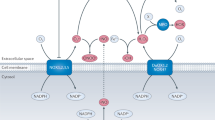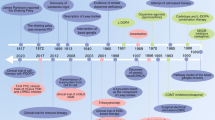Abstract
The inherited ataxias are a large, heterogeneous group of neurodegenerative disorders caused by a variety of gene mutations, the effects of which are exerted through different pathogenic mechanisms. Despite this diversity, oxidative stress seems to be a common factor in the pathogenesis of these disorders, indicating that antioxidants might be potential therapeutics for these currently incurable conditions. Some inherited ataxias, such as ataxia with vitamin E deficiency, are directly caused by defects in small-molecule antioxidants and might be treated by supplying the defective molecule. In most ataxias, however, oxidative stress has more-complex disease-specific causes and consequences, which must be better understood to enable effective treatments to be developed. Results from studies in cellular and animal models need to be brought to the clinic through rigorous trials. The rarity of each of these diseases can, however, make trial design and execution a very difficult task. Challenges include the development of validated clinical assessment tools and biomarkers, and the recruitment of a sufficient number of patients. Despite these obstacles, marked progress has been made in the case of Friedreich ataxia, a disease that has oxidative stress at the core of its pathogenesis. This condition seems to respond to idebenone, a coenzyme Q analog that has antioxidant and oxidative-phosphorylation-stimulating properties.
Key Points
-
Oxidative stress is a key factor in the pathogenesis of inherited ataxias, but the mechanisms involved vary between different conditions, necessitating distinct therapeutic approaches
-
Friedreich ataxia (FRDA) is caused by deficiency of a mitochondrial protein, frataxin, which has direct antioxidant and iron-regulatory functions, making this disease a prime candidate for antioxidant therapy
-
Clinical rating scales and biomarkers for FRDA are rapidly being developed and are beginning to be used in controlled, double-blind clinical trials
-
Several antioxidants have been tested in FRDA, but placebo-controlled, double-blind trials have only been conducted with idebenone; a recent phase II trial provided very encouraging results regarding the safety and possible efficacy of this drug
-
A few rare forms of ataxia are directly attributable to the deficiency of small-molecule antioxidants—such as vitamin E and coenzyme Q10—for which replacement therapy is possible
-
There is a rationale for testing antioxidants in ataxias attributable to DNA repair defects, autosomal-dominant spinocerebellar ataxias and ataxias with primary mitochondrial dysfunction, but no controlled clinical trials have been conducted to date
This is a preview of subscription content, access via your institution
Access options
Subscribe to this journal
Receive 12 print issues and online access
$209.00 per year
only $17.42 per issue
Buy this article
- Purchase on Springer Link
- Instant access to full article PDF
Prices may be subject to local taxes which are calculated during checkout

Similar content being viewed by others
References
Calabrese V et al. (2007) Redox regulation of cellular stress response in aging and neurodegenerative disorders: role of vitagenes. Neurochem Res 32: 757–773
Calabrese V et al. (2006) Redox modulation of heat shock protein expression by acetylcarnitine in aging brain: relationship to antioxidant status and mitochondrial function. Antioxid Redox Signal 8: 404–416
Pandolfo M (2006) Friedreich ataxia. In Genetic Instabilities and Neurological Diseases, edn 2 277–298 (Eds Wells RD and Ashizawa T) San Diego: Academic Press
Campuzano V et al. (1996) Friedreich ataxia: autosomal recessive disease caused by an intronic GAA triplet repeat expansion. Science 271: 1423–1427
Sakamoto N et al. (1999) Sticky DNA: self-association properties of long GAA.TTC repeats in R.R.Y triplex structures from Friedreich's ataxia. Mol Cell 3: 465–475
Herman D et al. (2006) Histone deacetylase inhibitors reverse gene silencing in Friedreich's ataxia. Nat Chem Biol 2: 551–558
Babcock M et al. (1997) Regulation of mitochondrial iron accumulation by Yfh1, a putative homolog of frataxin. Science 276: 1709–1712
Cossée M et al. (2000) Inactivation of the Friedreich ataxia mouse gene leads to early embryonic lethality without iron accumulation. Hum Mol Genet 9: 1219–1226
Puccio H et al. (2001) Mouse models for Friedreich ataxia exhibit cardiomyopathy, sensory nerve defect and Fe-S enzyme deficiency followed by intramitochondrial iron deposits. Nat Genet 27: 181–618
Pandolfo M (2006) Animal models of Friedreich ataxia. In Animal Models of Movement Disorders, 649–657 (Ed LeDoux M) London: Elsevier Academic Press
Rouault TA and Tong WH (2005) Iron–sulphur cluster biogenesis and mitochondrial iron homeostasis. Nat Rev Mol Cell Biol 6: 345–351
Martelli A et al. (2007) Frataxin is essential for extramitochondrial Fe-S cluster proteins in mammalian tissues. Hum Mol Genet [10.1093/hmg/ddm163]
Yoon T and Cowan JA (2003) Iron-sulfur cluster biosynthesis: characterization of frataxin as an iron donor for assembly of [2Fe–2S] clusters in ISU-type proteins. J Am Chem Soc 125: 6078–6084
Radisky DC et al. (1999) The yeast frataxin homologue mediates mitochondrial iron efflux: evidence for a mitochondrial iron cycle. J Biol Chem 274: 4497–4499
Chen OS et al. (2004) Transcription of the yeast iron regulon does not respond directly to iron but rather to iron-sulfur cluster biosynthesis. J Biol Chem 279: 29513–29518
Wong A et al. (1999) The Friedreich ataxia mutation confers cellular sensitivity to oxidant stress which is rescued by chelators of iron and calcium and inhibitors of apoptosis. Hum Mol Genet 8: 425–430
Bulteau AL et al. (2007) Oxidative stress and protease dysfunction in the yeast model of Friedreich ataxia. Free Radic Biol Med 42: 1561–1570
Santos M et al. (2001) Frataxin deficiency enhances apoptosis in cells differentiating into neuroectoderm. Hum Mol Genet 10: 1935–1944
Pianese L et al. (2002) Up-regulation of c-Jun N-terminal kinase pathway in Friedreich's ataxia cells. Hum Mol Genet 11: 2989–2996
Jiralerspong S et al. (2001) Manganese superoxide dismutase induction by iron is impaired in Friedreich ataxia cells. FEBS Letters 509: 101–105
Chantrel-Groussard K et al. (2001) Disabled early recruitment of antioxidant defenses in Friedreich's ataxia. Hum Mol Genet 10: 2061–2067
Emond M et al. (2000) Increased levels of plasma malondialdehyde in Friedreich ataxia. Neurology 55: 1752–1753
Schulz JB et al. (2000) Oxidative stress in patients with Friedreich ataxia. Neurology 55: 1719–1721
Tozzi G et al. (2002) Antioxidant enzymes in blood of patients with Friedreich's ataxia. Arch Dis Child 86: 376–379
Seznec H et al. (2005) Friedreich ataxia: the oxidative stress paradox. Hum Mol Genet 14: 463–474
Trouillas P et al. (1997) International Cooperative Ataxia Rating Scale for pharmacological assessment of the cerebellar syndrome. The Ataxia Neuropharmacology Committee of the World Federation of Neurology. J Neurol Sci 145: 205–211
Subramony SH et al. (2005) Measuring Friedreich ataxia: interrater reliability of a neurologic rating scale. Neurology 64: 1261–1262
Schmitz-Hubsch T et al. (2006) Scale for the assessment and rating of ataxia: development of a new clinical scale. Neurology 66: 1717–1720
Lodi R et al. (1999) Deficit of in vivo mitochondrial ATP production in patients with Friedreich ataxia. Proc Natl Acad Sci USA 96: 11492–11495
Hart PE et al. (2005) Antioxidant treatment of patients with Friedreich ataxia: four-year follow-up. Arch Neurol 62: 621–626
Banaclocha MM (2001) Therapeutic potential of N-acetylcysteine in age-related neurodegenerative mitochondrial diseases. Med Hypotheses 56: 472–477
Sugiyama Y and Fujita T (1985) Stimulation of the respiratory and phosphorylating activities in rat brain mitochondria by idebenone (CV-2619), a new agent improving cerebral metabolism. FEBS Letters 184: 48–51
Brière JJ et al. (2004) Quinone analogues regulate mitochondrial substrate competitive oxidation. Biochem Biophys Res Comm 316: 1138–1142
Sugiyama Y et al. (1985) Effects of idebenone (CV-2169) and its metabolites on respiratory activity and lipid peroxidation in brain mitochondria from rats and dogs. J Pharmacobiodyn 8: 1006–1017
Weyer G et al. (1997) A controlled study of 2 doses of idebenone in the treatment of Alzheimer's disease. Neuropsychobiology 36: 73–82
Thal LJ et al. (2003) Idebenone treatment fails to slow cognitive decline in Alzheimer's disease. Neurology 61: 1498–1502
Ranen NG et al. (1996) A controlled trial of idebenone in Huntington's disease. Mov Disord 11: 549–554
Rustin P et al. (1999) Effect of idebenone on cardiomyopathy in Friedreich's ataxia: a preliminary study. Lancet 354: 477–479
Mariotti C et al. (2003) Idebenone treatment in Friedreich patients: one-year-long randomized placebo-controlled trial. Neurology 60: 1676–1679
Ribai P et al. (2007) Neurological, cardiological, and oculomotor progression in 104 patients with Friedreich ataxia during long-term follow-up. Arch Neurol 64: 558–564
Seznec H et al. (2004) Idebenone delays the onset of cardiac functional alteration without correction of Fe-S enzymes deficit in a mouse model for Friedreich ataxia. Hum Mol Genet 13: 1017–1024
Artuch R et al. (2004) Cerebrospinal fluid concentrations of idebenone in Friedreich ataxia patients. Neuropediatrics 35: 95–98
Di Prospero NA et al. (2007) Safety, tolerability, and pharmacokinetics of high-dose idebenone administered to patients with Friedreich's ataxia. Arch Neurol 64: 803–808
Di Prospero N et al. (2007) Neurological effects of high-dose idebenone in patients with Friedreich's ataxia: a randomised, placebo-controlled trial. Lancet Neurol 6: 878–886
Tauskela JS (2007) MitoQ—a mitochondria-targeted antioxidant. IDrugs 10: 399–412
Pandolfo M and Dupondt C (2007) Friedreich's ataxia and related loss-of-function disorders. In Molecular Neurology, 277–294 (Ed Waxman SG) San Diego: Academic Press
Hirano M et al. (2007) DNA single-strand break repair is impaired in aprataxin-related ataxia. Ann Neurol 61: 162–174
Suraweera A et al. (2007) Senataxin, defective in ataxia oculomotor apraxia type 2, is involved in the defense against oxidative DNA damage. J Cell Biol 177: 969–979
Ziv S et al. (2005) Impaired genomic stability and increased oxidative stress exacerbate different features of ataxia-telangiectasia. Hum Mol Genet 14: 2929–2943
Gueven M et al. (2006) Dramatic extension of tumor latency and correction of neurobehavioral phenotype in Atm-mutant mice with a nitroxide antioxidant. Free Radic Biol Med 41: 992–1000
Erker L et al. (2006) Effect of the reduction of superoxide dismutase 1 and 2 or treatment with alpha-tocopherol on tumorigenesis in Atm-deficient mice. Free Radic Biol Med 41: 590–600
Soong BW and Paulson HL (2007) Spinocerebellar ataxias: an update. Curr Opin Neurol 20: 438–446
Bates GP and Hockly E (2003) Experimental therapeutics in Huntington's disease: are models useful for therapeutic trials. Curr Opin Neurol 16: 465–470
Artuch R et al. (2006) Cerebellar ataxia with coenzyme Q10 deficiency: diagnosis and follow-up after coenzyme Q10 supplementation. J Neurol Sci 246: 153–158
Mattiazzi M et al. (2004) The mtDNA T8993G (NARP) mutation results in an impairment of oxidative phosphorylation that can be improved by antioxidants. Hum Mol Genet 13: 869–879
Schulz JB et al. (2000) Oxidative stress in patients with Friedreich's ataxia. Neurology 55: 1719–1721
Artuch R et al. (2002) Friedreich's ataxia: idebenone treatment in early stage patients. Neuropediatrics 33: 130–193
Hausse AO et al. (2002) Idebenone and reduced cardiac hypertrophy in Friedreich's ataxia. Heart 87: 346–349
Rustin P et al. (2002) Heart hypertrophy and function are improved by idebenone in Friedreich's ataxia. Free Radic Res 36: 467–469
Buyse G et al. (2003) Idebenone treatment in Friedreich's ataxia: neurological, cardiac, and biochemical monitoring. Neurology 60: 1679–1681
Acknowledgements
Support to the author for research in inherited ataxias comes from the GoFAR foundation (Italy), the CRT foundation (Italy), the Friedreich Ataxia Research Alliance (USA), Ataxia UK, Ataxia Ireland, the Belgian Ministry of Scientific Policy (Interuniversity Attraction Poles 6), the Belgian National Scientific Research Funds (FNRS) and the European Community (Framework 6 integrated project EUROSCA).
Author information
Authors and Affiliations
Ethics declarations
Competing interests
M Pandolfo has acted as a consultant for ApoPharma and Santhera, and is a patent holder with Athena Diagnostics.
Rights and permissions
About this article
Cite this article
Pandolfo, M. Drug Insight: antioxidant therapy in inherited ataxias. Nat Rev Neurol 4, 86–96 (2008). https://doi.org/10.1038/ncpneuro0704
Received:
Accepted:
Issue Date:
DOI: https://doi.org/10.1038/ncpneuro0704
This article is cited by
-
Peptide SS-31 upregulates frataxin expression and improves the quality of mitochondria: implications in the treatment of Friedreich ataxia
Scientific Reports (2017)
-
Mesenchymal Stem Cell-Derived Factors Restore Function to Human Frataxin-Deficient Cells
The Cerebellum (2017)
-
Consensus Paper: Pathological Mechanisms Underlying Neurodegeneration in Spinocerebellar Ataxias
The Cerebellum (2014)
-
Drug Development for Rare Mitochondrial Disorders
Neurotherapeutics (2013)
-
Limitations in a frataxin knockdown cell model for Friedreich ataxia in a high-throughput drug screen
BMC Neurology (2009)



